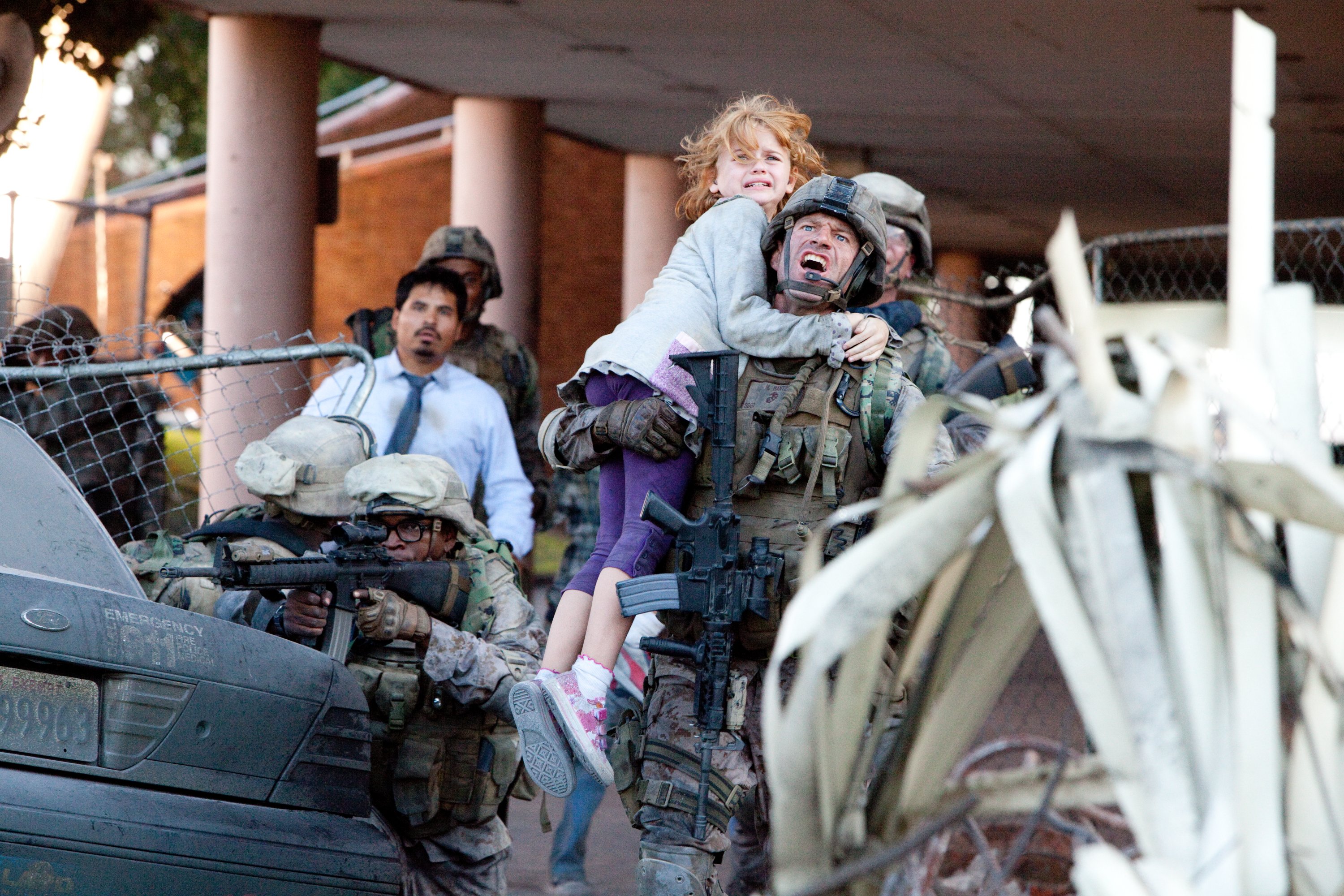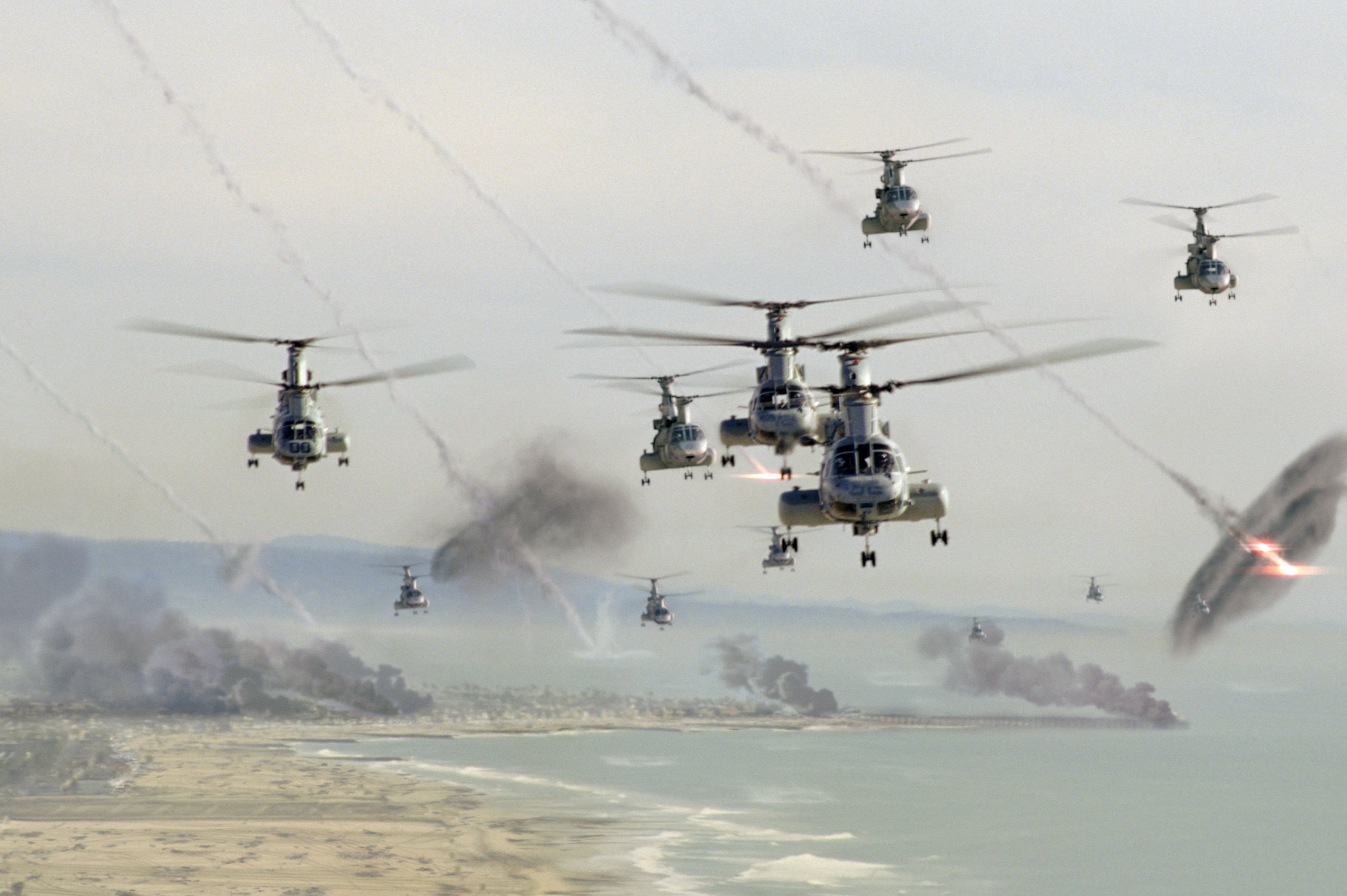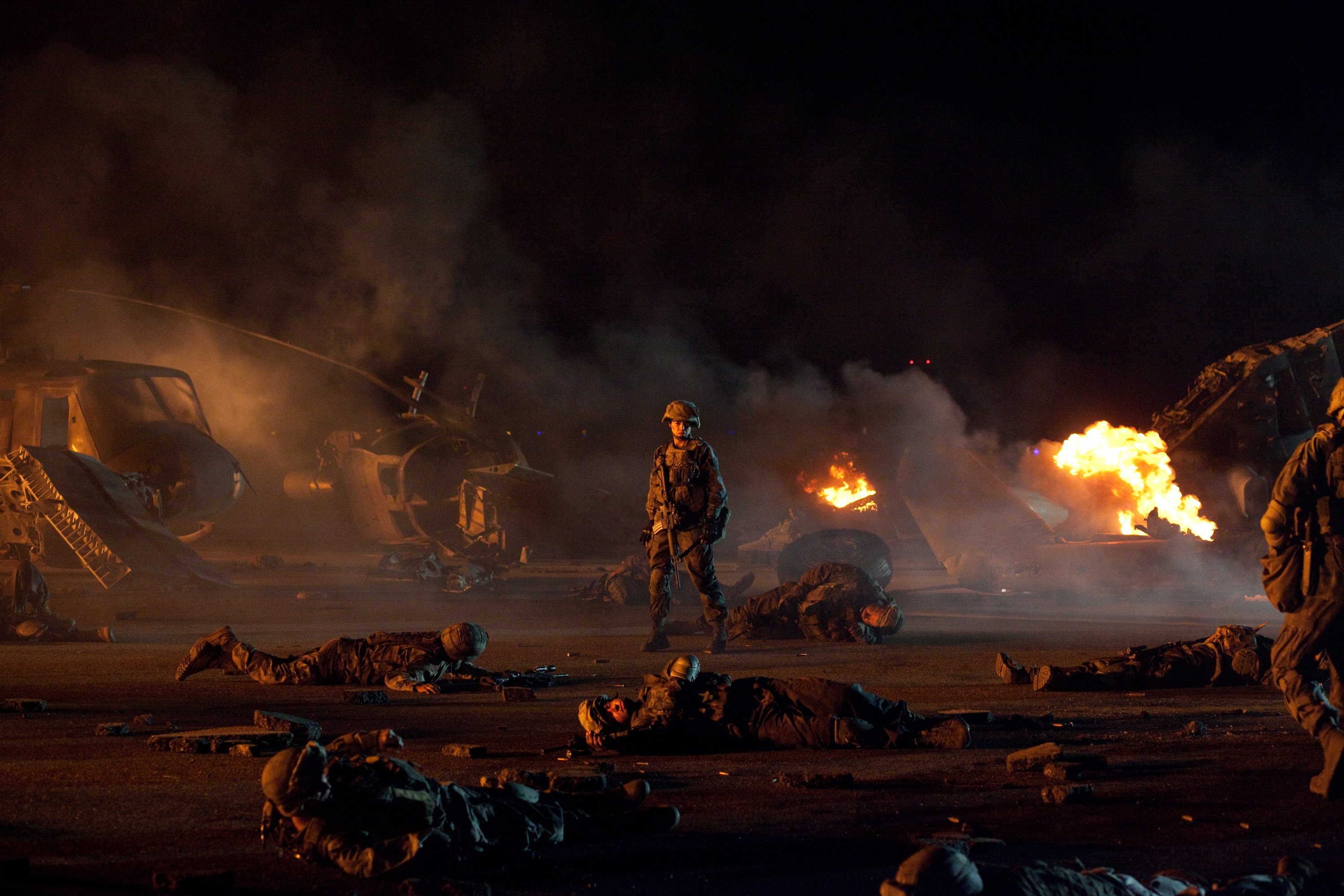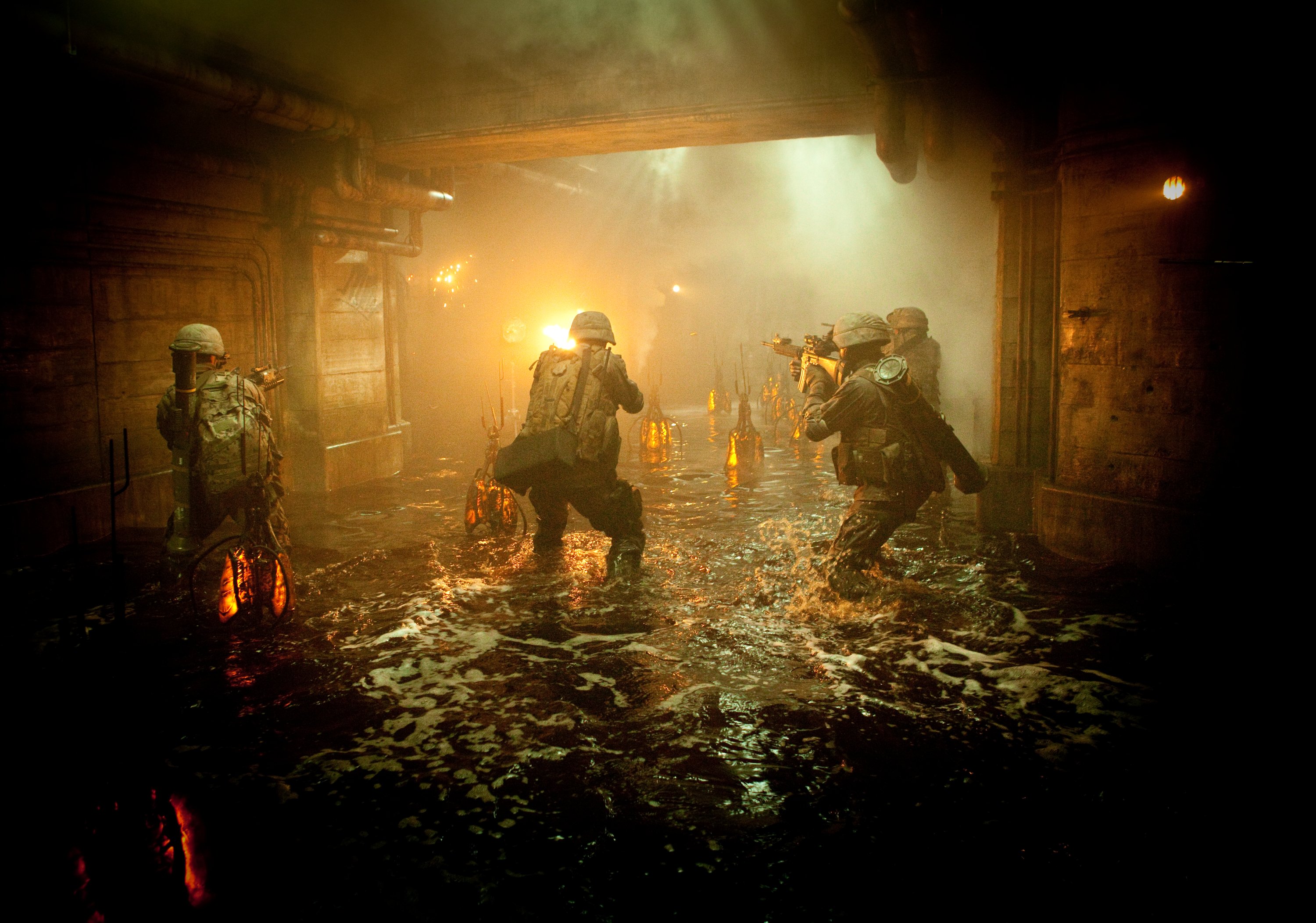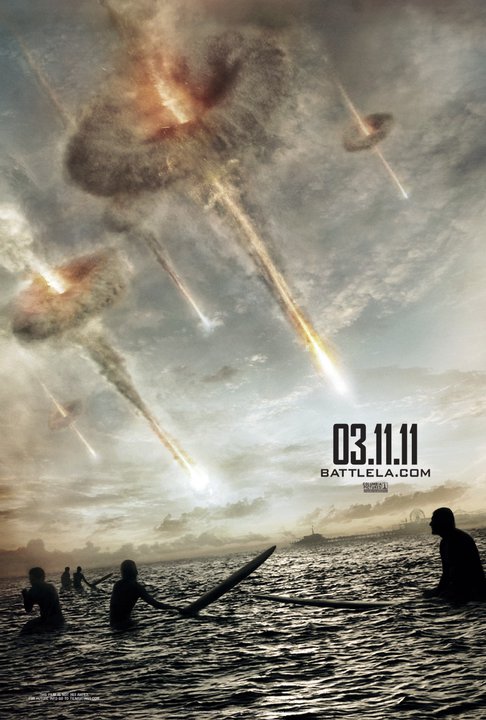 As I sat with a batch of other online film types in a white van heading towards the set of Battle: Los Angeles , I was a little anxious- at this point I was still a film school kid, and the idea of stepping onto a true-blue blockbuster film set was as nerve wracking as it was holy shit exciting. Was I going to show my ass around all of these jaded publicists and journalists when I got too excited about watching a film loader work, or seeing the sound cart roll by? Would I focus too much on the lighting set-ups or trying to catch a peek at the location mixer at work and miss out on something an A-list star did? These concerns were in the back of my mind as we pulled into Baton Rouge’s impressive filmmaking facility, that at the time boasted 5 main studio stages as well as a defunct Coca-Cola factory that added to the exploitable square footage. As we pulled into the gate and drove behind huge stacks of shipping containers that seemed to be buttressing a crumbling building facade of some sort, I turned to Katey Rich of CinemaBlend to remark on how much the set looked like an enormous lego-construction from behind, when all of sudden her face lit up and glowed orange. Behind me (I was later told) a massive fireball and billowing smoke were filling the sky over the primary set, apparently from an impressive explosion. This set the tone for the visit right away.
As I sat with a batch of other online film types in a white van heading towards the set of Battle: Los Angeles , I was a little anxious- at this point I was still a film school kid, and the idea of stepping onto a true-blue blockbuster film set was as nerve wracking as it was holy shit exciting. Was I going to show my ass around all of these jaded publicists and journalists when I got too excited about watching a film loader work, or seeing the sound cart roll by? Would I focus too much on the lighting set-ups or trying to catch a peek at the location mixer at work and miss out on something an A-list star did? These concerns were in the back of my mind as we pulled into Baton Rouge’s impressive filmmaking facility, that at the time boasted 5 main studio stages as well as a defunct Coca-Cola factory that added to the exploitable square footage. As we pulled into the gate and drove behind huge stacks of shipping containers that seemed to be buttressing a crumbling building facade of some sort, I turned to Katey Rich of CinemaBlend to remark on how much the set looked like an enormous lego-construction from behind, when all of sudden her face lit up and glowed orange. Behind me (I was later told) a massive fireball and billowing smoke were filling the sky over the primary set, apparently from an impressive explosion. This set the tone for the visit right away.
During my one-day visit to the set of Battle: Los Angeles, which took place well over a year ago in December of 2009, I visited three major sets, viewed a significant amount of action shooting (through monitors, and from the sidelines of the set), did a ton of interviews, and ate some pretty legit cajun food. A lot of interesting stuff was packed into a single day, despite the production being extremely secretive about the nature of some of the plot and the invading aliens. Some of this material has since appeared online or been made obvious through the trailers, but I think Battle: Los Angeles and its extraterrestrial villains still have some mysteries up their sleeves (or whatever). We were warmly welcomed by everyone involved in the production, but no one was happier to see us than director Jonathan Liebesman and star Aaron Eckhart. The two seem almost like a partnership, with them both sharing an intense passion and investment in the movie that feels parental. They were in this together. This is a vibe that is strongly reinforced by the set-up of the film itself, and the presence of a younger generation of actors populating the production- but I’ll get to that a bit later.
I’ll be covering the visit in two parts and today’s piece will explore the reasons for shooting in Louisiana, as well as the approach to the aliens. There’s still plenty to cover about the human characters, director Jonathan Liebesman’s style of directing and how he landed the project, as well as his relationship with Aaron Eckhart, so check back tomorrow for more!
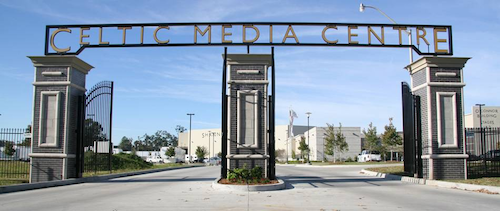
LA Stands For Louisiana…
The first thing you might be asking yourself is why Baton Rouge? You would think a film called Battle: Los Angeles would be a prime candidate for shooting home town in a time when film flight is such a problem. In fact, when I was first invited to the set I was a bit confused myself about the the location, since the title of the film made LA not register as Louisiana immediately. From what I saw on the set and in the trailers though, the city has stood in shockingly well and has allowed the production to make even their respectable budget go much father than it otherwise would.
The obvious benefits of shooting in a city like Baton Rouge – tax incentives, eager and film hungry locals, more flexible locations– are compounded by some of the hidden advantages. When a film of this scale (reports estimate an $80-$100m budget) rolls into town, the local studio is all too happy to accommodate them and shape their facilities based on the needs of a full-blown blockbuster. The Celtic Media Center in Baton Rouge (owned by the much larger Raleigh Studios) was in the unique position of having built acceptable sound stages that were not quite finished, which allowed the Battle: Los Angeles production to advise on finishing details that will make this studio useful for even the most demanding of productions in the future. Win win. Shooting in Louisiana also gave them a healthy distance form the studio that let them breath and work without fully dropping off the map, or being immune to oversight- a seemingly good balance of logistic considerations and creative flexibility.
But how does one make one city stand in for another convincingly? You have to ask production designer Peter Wenham.
“One of the issues when you shoot something out of LA or out of anywhere where the story is supposed to take place, rebates or that sort of thing, you ultimately end up recreating something, making it look like LA. While it might be described as somewhere unique, tuck it into more of a Venice Beach look. the architecture that is around Baton Rouge and downtown Baton Rouge, there is a little area called Spanish town. A lot of that architecture is reminiscent of Venice Beach. You twist and tweak locations in order to try and make it as convincing as you possibly can. Mixed with some things that we’ll build. take them on that journey. And the freeway as well.
We took over the freeway, closed it off, and we also built sides to it and built a background, enhanced it. Just being able to film in places like Baton Rouge, it’s a massive amount of flexibility you get. You don’t have to close things down. Which ultimately gives us an enormous amount of scope. It’s very important form my perspective, and important to me on this particularly, that it have some credibility, some believability about aliens. As real an envrionment as possible. Physical locations as opposed to making it work with CGI, which you see so much in so many movies at the moment. It’s important that you believe you’re in those environments as much as you can. The flexibility of closing thing off in places like Shreveport has been a big production bonus, rather than having it wrapped in a green screen environment. It depends on the scope of what you’re doing as well. The freeway is a big sequence in the movie. “
That freeway sequence he mentions turned out to be a looming specter over our entire visit, as everyone was still very much jazzed (or physically recovering!) from the intensity and heat of that piece of the shoot. In a roundtable with Jim Parrack, Michelle Rodriguez , and Neil Brown Jr. the three recounted the interesting challenges of shooting on a freeway in summer heat.
Michelle: No we were frying up there man, you don’t know what hot metal feels like till you got three fingers of your gloves cut off, and you happen to touch it by mistake.
Jim: I get out there for the first time and I’m like “ow” and she’s like “what?” and I say, “my balls are frying.“
Neil: I remember that! I didn’t want to bring it up, but-
*laughter*
If the trailer is any indication though, the freeway sequence is going to be intense.
That’s not the only extreme temperature challenge the cast was contemplating at the time though. Lucas Till, who plays Corporal Grayston in the film, apparently has a “a moment where [Taylor Handley’s character] teaches me to surf, in the movie. I can’t wait to shoot that in the middle of december.” I’ve not been able to speak to him since, but I have a feeling his balls ended up freezing as much as Jim’s were frying.
Aliens That Shoot Bullets
While the set visit could not have been handled by a more welcoming bunch of folks and the cast and crew could not have been more excited to show us what they were doing, there was still a marked hesitance to say too much about the aliens.
It was clear their design and approach was definitively outlined in director Jonathan Liebesman’s head, but the production was making it a priority to keep a handle on what details got out about them. In fact, when a mock-up of the species was brought onto the set, we were simultaneously taken to a small theater to screen the working sizzle reel for the film, which was mostly a collection of frenetic and aggressive urban combat footage that could have just as easily served as YouTube footage of Iraq mission video. What the other journalists and I could gather from the sizzle reel and snippets from other conversations is that the aliens are much more technologically grounded than we’re used to seeing. The most obvious sign of this is that the aliens are using bullets rather than lasers or force fields, a fact Michelle Rodriguez drove home as she discussed fighting against an enemy she knows so little about.
Michelle: The most intriguing part is that it’s not very clear, exactly what their capabilities are technologically. You know what I mean?
Neil: They can kill us.
Michelle: I’m like, how big are these freaking bullets that they’re shooting at us? Are they 50 cal? Are they like 150 cal? Is it something like what comes out of a tank here on earth? Like, how big are these freaking- and uh, nope, you just get a fucking big explosion and you just take it from there. And the bullets that come out of their guns –they do have guns– you just kind of measure it. There’s a difference between the guns that they carry physically when they’re walking, and then their ships. So one’s bigger than the other and that’s pretty much all we fucking know about this shit. I’m like, “do they have EMP? can they like completely wipe out our freaking systems? is that what they did?” None of that stuff is clarified. All of that will be clarified in a year’s time in post.
There’s something frightening to me about a force of aliens arriving on earth and subjugating us not with advanced technologies and overwhelming sophistication, but with the kind of brute force tactics that we humans are used to seeing used against each other. If these aliens truly are fighting with guns, standard munitions/explosives, and EMP type weapons, then that makes the warfare photography and ground-level approach all the more prudent. That’s a big focus for Liebesman, and while Black Hawk Down was the most oft-mentioned cinematic sibling, it was actually the world of video games that seem to offer the best point of reference for Battle: LA.
I have to say, usually a filmmaker will watch movies and be inspired, and I did find myself getting a lot of inspiration just watching gameplay and Call of Duty. It’s not first-person shooter anymore as much. What you see is the camera in different perspectives. What’s great about the gameplay is there’s a ton of production value in these games. If we can do this and make it feel real, that’s amazing. I think games, game commercials, there’s some great directors that have done some good recent game commercials, whether it’s my boy Neill Blomkamp, or Rupert Saunders, who did Halo ODST, what have you. Joseph Kosinski. There’s guys who are doing some great things, to be that was where the inspiration for this came from. I find those have been my inspiration as opposed to movies, like YouTube stuff. That’s from a very stylistic point. Beneath that, embedded Iraqi war footage obviously, which has inspired those things.
The younger cast members were apparently a bit too heavily influenced by Call of Duty and the like, staying up till all hours- but you’ll get more of a taste of that in tomorrow’s piece and the full roundtable interviews…
In any event, even if the aliens are fighting us with something like our own weapons, there’s definitely some “next-level shit” going on in the film as well (to quote another alien aficionado). Before the set visit, we were mysteriously asked for our shoe sizes. For what reason none of us could guess, but it became clear when we were led to a set housed in a bigger stage- a set filled waist deep with water. Apparently our heroes will be doing some major sewer traveling, as Peter Wenham had cooked up an elaborate and detailed sewer set that was complete with three feet of water, dripping pipes, steam, ladders, and a manhole covers. We were provided with thigh-high rubber boots so that we could wade through the set, following Peter and clutching our various recordings devices (an iPhone in my case) with all of our might. The twisting tunnel section of the sewer set was designed to be shot from different angles and be used for several scenes, which Peter used as an opportunity to describe the challenge of doing production design for a story of constant movement and travel.
This tunnel kind of doubles up for three sets. We revamp it and redress it, coming from different angles and directions. They ultimately end up disappearing up a ladder somewhere. Backtracking from where they entered they encounter other stuff that happened throughout the film. Ultimately ending up in the end there, which you can’t see, they end up in our third act. This just gives you a flavor of one of the textures taking you through the film. Most of the film is a long journey. From start to finish it just doesn’t stop. There’s no going back to any location like normal storytelling. This is a continual journey that doesn’t stop from start to finish. It’s a bit of a roller coaster ride. Its sort of the seat of your pants if you like.
The largest “chamber” of the sewer was obviously a key location though, and not likely to be re-purposed. Peppered with strange glowing pods (which you can see in this brand new still from the film), the devices made it clear the aliens were not just interested in wacking every human being they could and splitting town- whether the pods are a means for the aliens to reproduce (the word “incubation” was dropped, but was probably meant more generally) or some kind of weapon we were not told. Whatever their purpose, it probably would not be good for us. The few details we got, again came from Peter-
These aliens, although it’s not specifically described, are incubating. They’re down on our planet because water is what they’re after. It’s never quite explained, but if you watch the film you see why they’re drawn to water. These buoy things are doing something strange and weird. We all call them buoys. They’re not really described or explained what they, but they are churning water, redistributing water, sucking it up.
The mystery remains.
To be continued….
DISCUSS THIS on the CHUD Message Board
&
Like / Share it on Facebook (above or below) if you think it’s great!
[A big thanks to Katey Rich for transcribing many of these interviews.]
